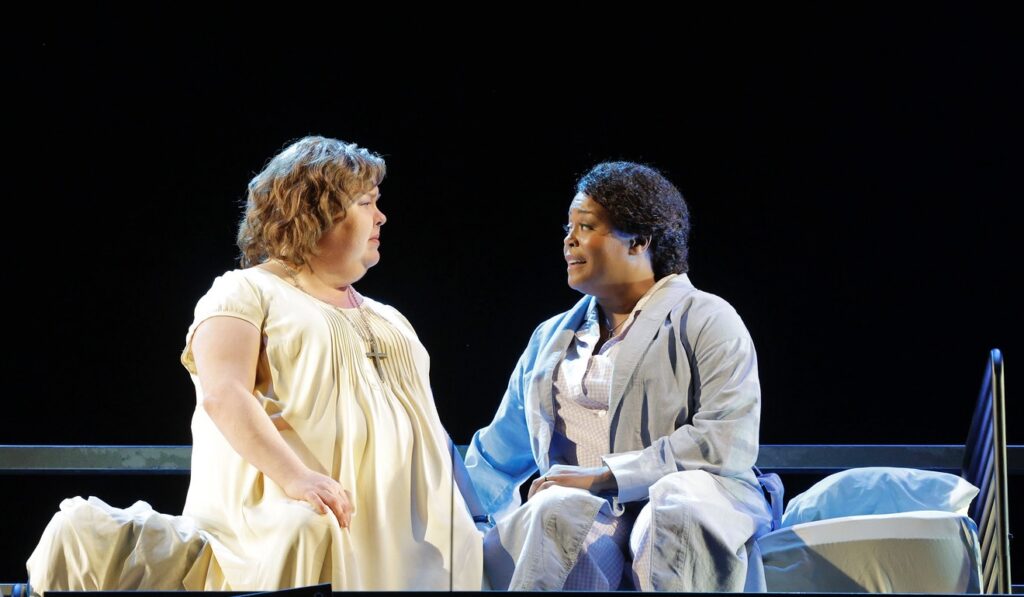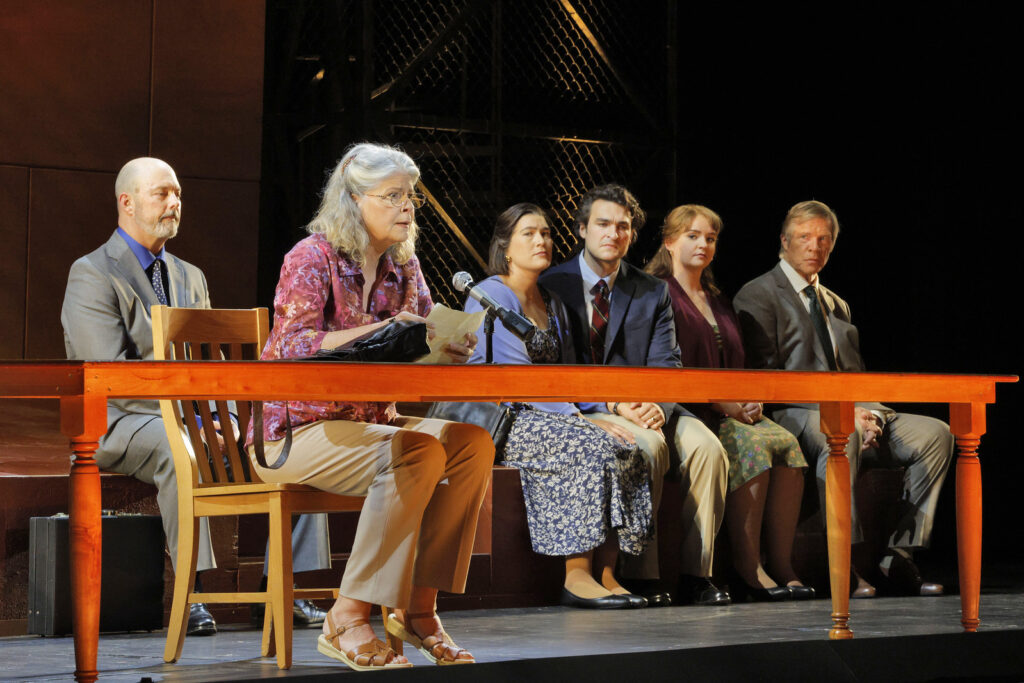Though one may chafe at the dramatic and musical naïveté of Jake Heggie’s Dead Man Walking, you will admit that it packs a wallop.
A man is summarily murdered in plain view.
Hardly a novel happening in opera. But in Dead Man Walking it raises, in three fraught hours, personal, moral, ethical, philosophical and political questions. Not to mention that it is wrapped in Christian mythology. There is something for everyone to chew on. Or not.
Of course the opera barely scratches the surface of such complex issues, even though relevancy is quite the thing in these recent years. Heggie’s Dead Man Walking remains the tale of a simple woman who is confounded by big issues, resolving them into the mantra of a simple song.
The libretto for Heggie’s opera is by Terrence McNally, a much Tony decorated creator of books for Broadway plays and musicals. The opera is based on the 1993 non-fiction book Dead Man Walking by Sister Helen Prejean, CSJ, a spiritual advisor to death row inmates in Louisiana. It became a movie in 1995, screenplay by Tim Robbins, who was Oscar nominated for best director as well.
Dead Man Walking is purported to be the most performed contemporary opera, worldwide. It was a San Francisco Opera commission during the Lotfi Mansouri years, its premiere in the year 2000 was in a production directed by Joe Mantello who soon gained much greater fame as the director of the 2003 blockbuster musical Wicked.

This twenty-fifth anniversary of San Francisco Opera’s vaunted Dead Man Walking is, instead, in the 2002 production by Leonard Foglia from Lyric Opera of Chicago, eschewing the 2023 production at the Met by Belgian director Ivo van Hove, though sharing two of its primary players, Susan Graham as Joe’s mother, and Ryan McKinny (lead photo) as the dead man walking (for some strange reason Sister Helen gets the last bow though she is not the name of the show).
The much travelled Leonard Foglia production (including to Orange County’s long defunct Opera Pacific) has been upgraded over the years. The sets by Broadway designer Michael McCarty have been updated and refurbished, including the projection designs, now video, by Elaine J. McCarthy, whose credits include Wicked.
The roots of Dead Man Walking are very much in American musical theater and popular American culture. It is indeed a “show!”
Patrick Summers, a San Francisco Opera protégé now artistic and music director of Houston Opera, was the opera’s original conductor. Now, as then, he presided over Heggie’s full symphonic orchestra of triple winds and brass, though 5 horns, tympani, harp, piano and strings, to create a huge, musical theater style wall of sound (amplification was certainly not needed or used), though with a few lovely moments of sonic respite here and there. There were important, much ballyhooed interjections of concrete music (car radio, heart monitor, crashes, etc) that were over amplified and poorly positioned.
While Jake Heggie operas seldom enjoy a succès d’estime they do find popular success. The nun Helen Prejean, here sung by mezzo-soprano Jamie Barton, found enormous and contagious moral stature. Bass-baritone Ryan McKinny realized the multi-dimensional murderer Joe De Rocher (a fictional name in the book, movie and opera). Mezzo-soprano Susan Graham, the opera’s original Sister Helen, gave a nicely sung, multi-dimensional performance as Joe’s mother. Soprano Brittany Renee, last season’s hyper-raucous Musetta, was the demure Sister Rose in beautiful voice.

Bass Raymond Aceto was the full voiced prison warden, tenor Chad Shelton played the prison chaplain. Bass-baritone Rod Gilfry sang the father of the murdered girl, reprising the paternal stature he created in Sariaho’s masterful Innocence two seasons ago. His estranged wife was sung by Caroline Corrales. The parents of the murdered boy were played by tenor Samuel White and mezzo-soprano Nikola Printz.
The phony southern accents were cringeworthy.
These larger roles comprise ten of Dead Man Walking’s 29 named roles. The remaining roles were attributed to San Francisco Opera’s Adler Fellows [its young artist program], its usual cache of comprimarios, and its choristers (though there were 36 additional, un-named choristers as well). There was a children’s chorus to open and close the first act, and 31 supernumeraries.
It was no small undertaking.
Michael Milenski
War Memorial Opera House, San Francisco, California, September 23, 2025
All photos copyright Cory Weaver, courtesy of San Francisco Opera.